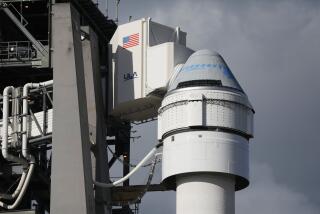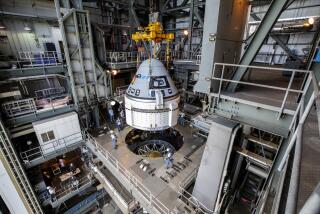Warning Signals Were Lost : Humans vs. Technology: How NASA System Failed
- Share via
WASHINGTON — The latest round of public testimony before a presidential commission investigating the Challenger disaster revealed that the space agency’s system of human checks against technical defects failed on a surprising number of levels, each time coming frustratingly close to avoiding the tragedy.
While commission members focused attention on flaws in the National Aeronautics and Space Administration decision-making process, testimony from a parade of witnesses during three days of public hearings demonstrated that in the final 24 hours of the Challenger countdown, three distinct warning signals did get sounded--only to be lost somewhere in the bureaucratic pyramid that drives the shuttle system.
The top rung of NASA managers--the men with their fingers on the firing button--testified with distressful unanimity that, had they known or fully comprehended any one of these signals, the flight would have been stopped.
Ironically, had the alarm bells been heeded and the flight stopped, it would have gone down in history not as a dramatic rescue, but rather as just another nagging delay in a shuttle schedule increasingly plagued with postponements.
And the men now reduced to the powerless role of witnesses after the fact would have been unknown heroes.
This week’s hearings ended the first phase of the commission’s 120-day assignment from President Reagan to determine the cause of the Challenger disaster and recommend fixes. The 13 commission members and their staff now will divide into teams and begin pursuing technical leads--although mounting photographic evidence points directly at a ruptured booster rocket seal as the accident’s most likely cause.
At the conclusion of the hearings, Chairman William P. Rogers announced the panel’s first conclusion: The system NASA employed to decide whether it was safe to launch the Challenger was “clearly flawed.”
The testimony, which filled more than 700 pages of typed transcript, revealed how much room there was for human foibles and vulnerabilities to seep into the process of deciding whether it was a reasonable risk to send the crew of seven into space.
Like a computer that depends on the essential input to give the correct answer, the system fell victim to human error or misjudgment. Pressures and frustration undermined the detailed charts and the calculations. Restrictive job definitions and bureaucratic processes choked the flow of vital information.
‘Human Error Failing’
“I don’t think the system is at fault,” said Seymour Himmel, a private aerospace consultant who left NASA in 1981 after 33 years with the agency and its predecessor, the National Advisory Committee for Aeronautics. “You have a human error failing, which is true in almost every venture of mankind. It’s akin to computers. They don’t normally make mistakes, but if there’s a wrong input, it will give you a wrong answer.”
To Donald K. (Deke) Slayton, one of the nation’s first seven astronauts, the revelations were not surprising: “You depend on managers to make a decision based on the information they have,” said Slayton, now president of an aerospace company in Houston. “To transmit all the fine detail to the top people, it wouldn’t get launched but once every 10 years.
“You’ve got to delegate authority and assume they are taking everything into consideration. NASA is people.”
Still Bristling
Propulsion experts at NASA’s Marshall Space Flight Center in Huntsville, Ala., were still bristling Friday about testimony that depicted them as the kink in the flow of warnings to the launch control room. Their top people had not passed along to launch control officials concerns about how cold weather would affect solid rocket seals.
Some outside aerospace experts, however, said they were horrified by testimony indicating that Morton Thiokol Inc. executives did not allow their engineers to vote when the decision was made to reverse an earlier recommendation against launch.
“I can’t imagine trying to muffle dissent on my technical staff,” said one private aerospace executive. “If you’re the manager of a highly complex aerospace system, that’s the last thing you want to do.”
Photograph analysis and temperature readings introduced at the hearings eliminated two other possible causes of the accident--that a tiny leak test porthole in one of the booster rocket seams had not been properly closed, or that supercooled fuel from an adjoining external fuel tank had dripped into a rocket joint, damaging its seal.
Engineers’ Warnings
The new findings brought heightened relevance to testimony about warnings from engineers with Morton Thiokol that the launch should be halted because cold weather at Cape Canaveral could undermine the effectiveness of the crucial seals.
The testimony, though often couched in the dry technical language of engineers, was nonetheless freighted with emotion as it became increasingly clear how close NASA’s system of assuring flight safety came to working:
--Morton Thiokol rocket engineers, among the nation’s best, unanimously warned that launching Challenger in cold weather could lead to a catastrophic explosion. But the warnings--possibly for reasons of human weakness, professional pride or faith in a bureaucratic process--never reached the launch control room.
--Launch-pad technicians took appallingly low temperature readings on the spacecraft’s right-hand booster rocket. But the readings were not reported to anyone who could have interpreted them as a clear signal that conditions were primed for disaster. Why? The rockets were not the team’s concern; the temperatures were taken for reasons of academic curiosity--”in case anybody ever wanted to make a study on them.”
--Two hours before liftoff, top officials of Rockwell International, the company that built Challenger, cautioned against launching from a pad encased with thick ice. It would be a dangerous journey into unknown dynamics, they warned. Or at least thought they warned. But the people who counted did not hear what the contractor representatives thought they said, and another chance was squandered.
Never Seen Before
Gerard W. Elverum, vice president of applied technology of TRW in Redondo Beach, Calif., and a member of a nine-member NASA safety review team, said he has never before seen any evidence that the flow of information between NASA and its contractors was deficient.
“We have been in many launch reviews,” Elverum said. “My impression is they were excellent procedures, as good as you can do. They tried to bring out all relevant information at the proper level.”
Elverum said the history, and the level of concern, about the booster rocket seals also never reached the attention of the entire panel. He said the panel probably will change its procedures to “have a better chance to get access to these concerns before they become readiness issues at flight readiness reviews.”
Rogers concluded that the testimony showed the entire prelaunch decision-making process has become flawed, mired in paper work and Catch-22-like command chains that seem to loop back on themselves before reaching the proper levels. The hearing transcripts are littered with officials explaining how they did not believe they were required to pass along concerns, or were confident that they were operating within a long-established “envelope” of launch criteria.
“The trouble with so much paper work,” an increasingly exasperated Rogers berated NASA officials at one point, “is that you eliminate the elements of judgment and good sense.”
Possible Design Flaws
Perhaps more damaging to the shuttle’s future will be any design flaws pinpointed by the commission, and members with the most expertise in aeronautic systems seemed increasingly dismayed that the fleet had not been grounded before the Challenger disaster to correct a pattern of erosion in the seals.
More to Read
Sign up for Essential California
The most important California stories and recommendations in your inbox every morning.
You may occasionally receive promotional content from the Los Angeles Times.












